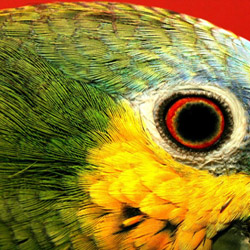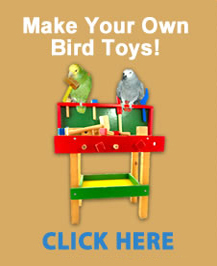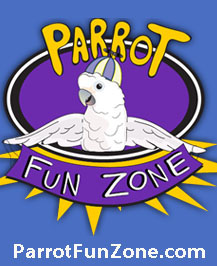- Written by: Deb White
- Category: Security
 Security is the condition of feeling protected against danger. A lack of security causes stress which can negatively impact your birds health. Stress often leads to undesirable behaviors such as feather picking, screaming and biting.
Security is the condition of feeling protected against danger. A lack of security causes stress which can negatively impact your birds health. Stress often leads to undesirable behaviors such as feather picking, screaming and biting.
It is important to remember that even though we "train" our hand raised parrots to adapt to the human environment, their behavior is still largely influenced by their instinctive tendencies and as such will react to stimuli in their environment based on these instincts.
Parrots are prey animals which means that predators in the wild, such as hawks or snakes, are looking to make them into a meal. Have you ever noticed how frightened parrots get with sudden loud noises or movements from above or behind ? Ever make the mistake of letting a helium balloon float by your bird's cage ? Even the snakelike vacuum cleaner cord/hose can evoke a negative reaction. Our parrots are instinctually hardwired to be on alert for danger 24/7. It is up to us to realize how instinctively vulnerable our birds feel and to help them feel as safe as possible. We can do this by:
- ensuring that the physical arrangement of their environment supports this goal,
- careful observation of our bird's body language so we can note what situations create a fearful reaction,
- avoiding events that threaten your bird, and
- reassuring our birds when they look fearful.
A parrot derives its greatest sense of security from living within a flock. In the wild, activities such as feeding, flying and grooming are performed communally. Since parrots are flock animals, they are also emotionally geared to live as part of a group. Parrots left in isolation without the benefit of direct contact and interaction do not develop a sense of security. Parrots need to interact with their household flock to become comfortable and develop a sense of belonging.
Cage Placement
The decision on where to place your bird's cage is a critical one. Placing at least one side of the cage against a wall may help your bird feel sheltered from predators. Placement opposite the entry to the room allows your bird to observe who is approaching and what is going on. Also, avoid placement in a room with a ceiling fan or directly in front of a window so they can relax and stop worrying about flying predators.
Utilizing cage covers, tents or a perch surrounded by lots of toys can also provide a parrot with opportunities to hideaway and feel more secure when they want to sleep.
Routines
Parrots are less stressed when there are household routines that provide them with the opportunity for regular sleep hours, regular feeding and watering times and special one on one time. Since they have no means to do it for themselves in captivity, parrots are entirely dependent on us to provide them with clean water and a nutritious diet. They need to know they can rely on this.
Interactive rituals also reinforce your parrot's sense of security. For example, greetings in the morning, goodbyes when leaving for the office, game playing when coming home, silly songs during activities such as feeding or bathing all help to reassure your bird.
Change is Good
The earlier in life that you start to expose your bird to changes of a non-threatening nature, the less likely they will be threatened by things commonly encountered in life such as household moves, family additions, time away from their flock (vacations, business trips). Variations in diet and toys, travel, and exposure to new people and places all help to make your bird more flexible and adaptable to change.
- Written by: Deb White
- Category: Security
 How birds perceive the world around them determines their many choices and behaviors, including foraging, predator avoidance, mating and flight. Birds rely on their senses to aid in their survival. A parrot's visual and auditory senses are the most critical to their survival and as such, are the most well developed of the senses. Conversely, a bird's sense of smell and taste are less critical to their survival and are less developed.
How birds perceive the world around them determines their many choices and behaviors, including foraging, predator avoidance, mating and flight. Birds rely on their senses to aid in their survival. A parrot's visual and auditory senses are the most critical to their survival and as such, are the most well developed of the senses. Conversely, a bird's sense of smell and taste are less critical to their survival and are less developed.
A Bird's Eye View
Vision is a parrot's most critical sense as it is important for their ability to survive. It is typical for prey animals to have their eyes spaced widely on their head and this is the case for parrots. With their eyes placed on the side of their heads, they are better able to monitor movement from all angles and they have close to 360° view. A few other interesting facts about a parrot's eyesight are:
- Birds have eyeballs that are relatively large in comparison to the size of their head.
- Parrots have two fovea per eye, which operate independently. This enables them to focus on more than one object at a time.
- The lateral placement of their eyes results in a limited binocular field. This means that parrots have poor depth of field perception.
- Birds have the ability to focus much faster than other animals.
- Birds close their upper and lower eyelids only to sleep.
- Birds have a transparent third eyelid for blinking that sweeps across the eye from the inside to lubricate and clean the cornea. The transparency of this eyelid helps them to remain aware of their surroundings.
- Night vision is poor in parrots making them more vulnerable to attack at night from owls and bats.
- Compared to humans, parrots can distinguish more colors and see a wider range of colors due to their ability to distinguish UV light.
Do They Hear What I Hear?
The ability to hear is very important to a bird's existence in the wild, especially since they often rely on communications between flock members to warn of predators. Here's a few facts:
- Birds can hear a smaller range of sound than humans. Birds are less sensitive to the high and low ends of the frequency range.
- Birds can distinguish rapid fluctuations in pitch and intensity much better than humans can. The replay speed of a bird's call would have to be slowed by a factor of 10 for us to be able to discern all the details a bird can hear.
- Parrots don't have external ear structures but they do have inner ear three chambers just like we do.
- A parrot's middle ear has only one bone versus the three bones (Hammer, Anvil and Stirrup) found in human ears.
- Specialized feathers (auriculars) surround the ear opening that protect the ear opening without blocking the sound.
Can Parrots Distinguish Odors?
For many years, birds were considered to have a poorly developed sense of smell. Recent research has rejected that hypothesis. Although there haven't been parrot specific studies in regards to their olfactory abilities, it has been documented that the sense of smell is critical to many other species for routine tasks such as navigation, foraging and mating.
How Discerning is a Parrot's Palette?
Compared to humans, a parrot's sense of taste is very limited but as we all know, they do have definite likes and dislikes.
- Birds typically have fewer than 100 taste buds in comparison to about 10,000 in humans.
- A bird's sense of taste may be used to help them avoid harmful foods.
- A distinct oddity of a bird's tongue is that it has a bone in it that runs the full length.
- Because a parrot's tongue is hardened on the end, the taste buds are located at the back of the throat and the base of the tongue.
Touch
A bird's skin has sensory nerve endings that detect temperature, pressure and pain.
Write comment (9 Comments)- Written by: Deb White
- Category: Security
 Parrots are flock animals. Some parrots flock in single species flocks (i.e., African Greys) and other birds operate within mixed species flocks (i.e., Amazons, Conures and Macaws). Different species can have different social needs and behaviors as necessary for them to survive in their specific habitat. Flock size can range from a few to several hundred birds. Flock size can also vary throughout the day depending on the activity. For example, flocks may break into smaller groups for foraging and then recombine at night into larger roosting communities.
Parrots are flock animals. Some parrots flock in single species flocks (i.e., African Greys) and other birds operate within mixed species flocks (i.e., Amazons, Conures and Macaws). Different species can have different social needs and behaviors as necessary for them to survive in their specific habitat. Flock size can range from a few to several hundred birds. Flock size can also vary throughout the day depending on the activity. For example, flocks may break into smaller groups for foraging and then recombine at night into larger roosting communities.
For prey animals, living within the context of a flock is often necessary for survival. A parrot derives it's greatest sense of physical and emotional security from living within a flock. Parrots are rarely alone in the wild. A parrot's survival instincts tells them that they are unsafe when they are alone. A single parrot in the wild is likely a bird who is going to die because of injury, illness or old age and who has been abandoned by the flock because he presents a risk to their safety.
Flocks travel, eat, play and roost together. It is very difficult for a lone bird to simultaneously forage and watch for predators. While the flock participates in group feeding activities there are many sentinels with their eyes on the lookout for predators and at the ready to warn their flock mates.
Common predators of parrots in the wild are hawks, eagles, owls, monkeys, snakes and bats. By far, hawks present the greatest danger due to their ability to swoop down on a parrot at speeds approaching 200 miles per hour. However, it is much harder and confusing for a predator to single out and attack an individual bird when it is moving as part of a group of birds.
A typical daily schedule for a flock of parrot's looks like:
- Awaken (just before dawn)
- Fly to foraging site (sunrise)
- Rest, groom, bathe, play (mid-day)
- Return to foraging site (afternoon)
- Find communal roosting site (just before sunset)
Besides security, living as part of a flock offers many benefits including opportunities for:
- Social Interaction
- Physical Play (chases, mock fighting, beak fencing)
- Learning
Parrots have well developed communication skills and use many vocalizations to communicate with their flock. Parrots use vocalizations to greet and acknowledge each other and provide warnings if necessary. Their natural ability to "learn" our language and interact vocally is one of our parrots most enduring traits.
Because of their instinctual need to be part of a flock, parrots love to be included in the day to day activities of their human flock to the extent practicable and safe. Including parrots in activities such as meals, showers or TV time will give them a stronger sense of belonging.
Write comment (0 Comments)- Written by: Deb White
- Category: Security
 Parrots are prey animals which means that other predators in the wild, such as hawks or snakes, are looking to make them into a meal. This one factor influences parrots behavior in captivity more than any other.
Parrots are prey animals which means that other predators in the wild, such as hawks or snakes, are looking to make them into a meal. This one factor influences parrots behavior in captivity more than any other.
Parrots are most vulnerable when feeding on the ground; membership in a flock plays an important function in ensuring their safety and improving their odds of survival from attacks by predators. The most common predators of parrots include:
- Raptors (hawks, eagles, owls)
- Snakes
- Cats (jaguars, ocelots)
- Monkeys
- Bats
Some predators pose risks only during the day while others are night stalkers (owls, bats).
As prey animals, parrots are on constant alert for danger and they instinctively react (fight or flight response) to perceived threats. Their first choice is to escape (flight) however, if this is not possible, they will attack (fight) with their powerful beaks to defend themselves.
Because their most threatening opponent is the hawk, parrots are especially reactive to quick movements from above and behind. For this reason, it is wise to avoid quick, sudden movements near your bird. This is a built-in instinctual reaction not subject to logic or reason. Simple and relatively innocuous household objects can illicit extreme fear responses in a bird. For example, a helium balloon may represent a hawk or a vacuum hose may equate to a snake in your bird's mind.
Prey animals are genetically designed to be very visual and their eyes are well tuned to help detect threatening movement from quite a distance. For more information on avian sensory perception, refer to our related article Avian Senses and Survival.
As prey animals, parrots are often suspicious or threatened by exposure to new household items or strangers. It is important to expose your bird to non-threatening experiences and changes starting at a very young age to build flexibility and enhance their adaptability. Variations in diet and toys, travel, and exposure to new people and places all help to make your bird more flexible and adaptable to change.
Write comment (3 Comments)

















































































































































